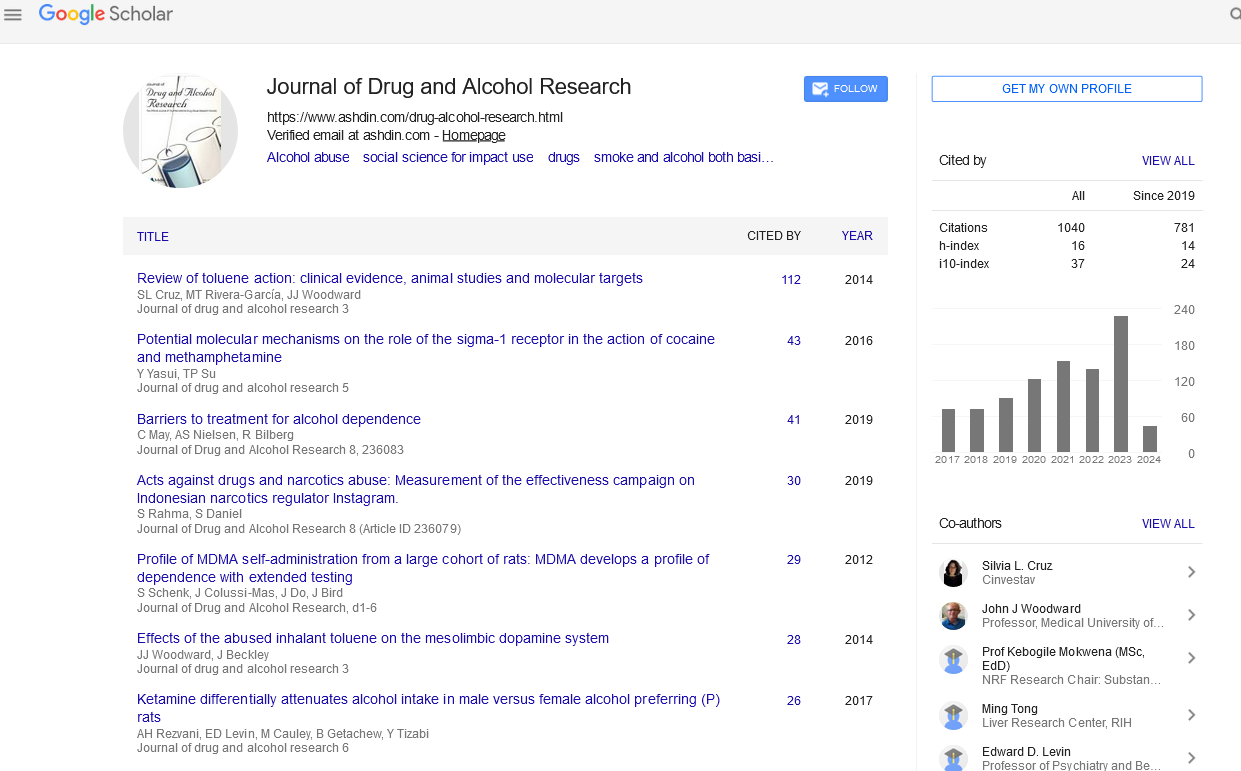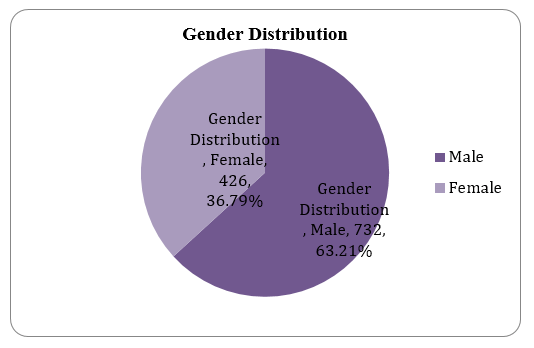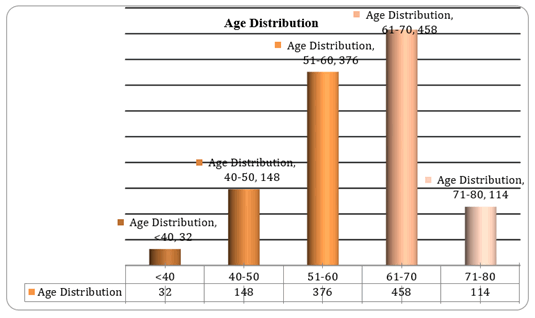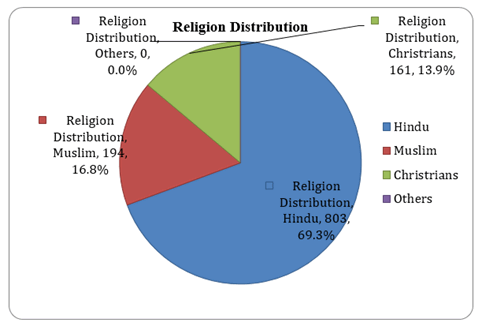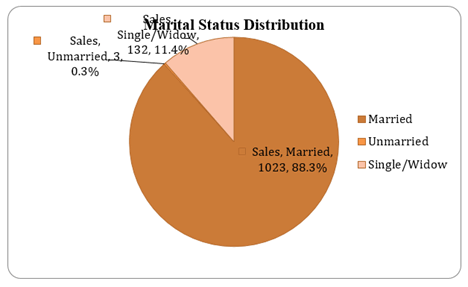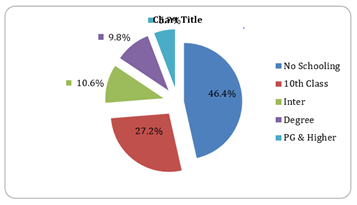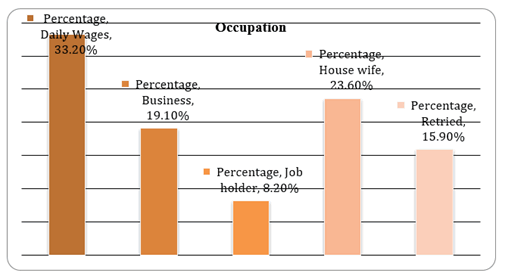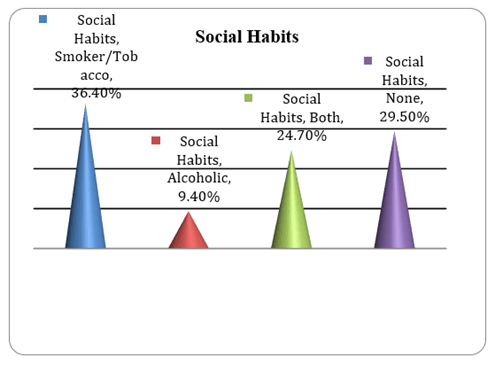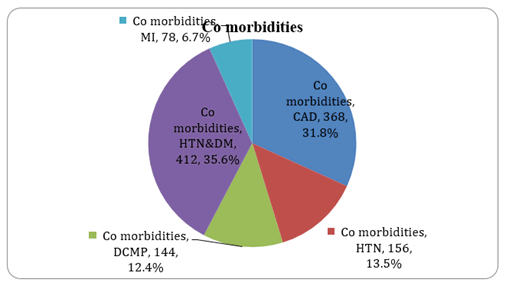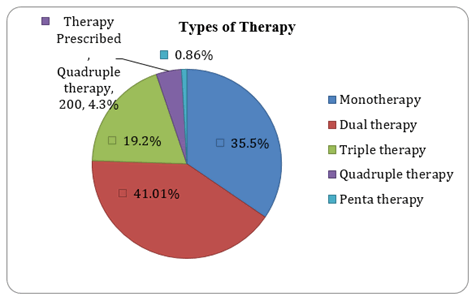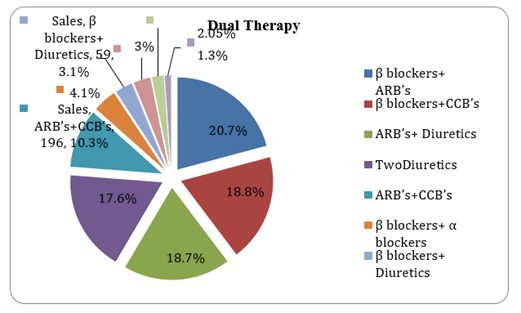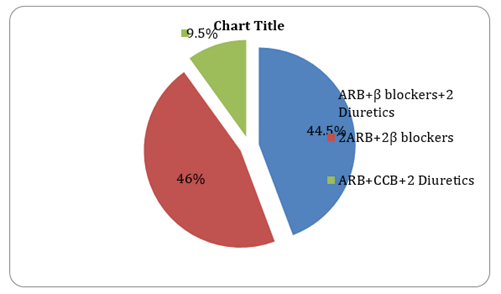Research Article - Journal of Drug and Alcohol Research ( 2024) Volume 13, Issue 12
Current Prescription Trends among Cardiology Patients
Nutakki Tulasi Uma Rani1*, Dinesh Kumar Upadhaya1 and Rajesh Akki22Depatment of Pharmaceutics, Hindu College of Pharmacy, India
Nutakki Tulasi Uma Rani, Depatment of Pharmacology, Jaipur National University, India, Email: nturani35@gmail.com
Received: 02-Dec-2024, Manuscript No. JDAR-24-129984 ; Editor assigned: 04-Dec-2024, Pre QC No. JDAR-24-129984 (PQ); Reviewed: 18-Dec-2024, QC No. JDAR-24-129984; Revised: 23-Dec-2024, Manuscript No. JDAR-24-129984 (R); Published: 30-Dec-2024, DOI: 10.4303/JDAR/236422
Abstract
The study aims to understand the specific patterns and trends in the prescription of antihypertensive drugs among Cardiovascular Diseases (CVD) patient. This was a prospective observational study over a period of 24 months on cardiovascular diseases patients attending Cardiology departments. The prescription of these patients was evaluated to understand the prescribing pattern of antihypertensive drugs. Monotherapy accounted for 34.5%, with Beta blockers most commonly prescribed. The majority of prescriptions 41.01% involved dual therapy, with β-blockers+ARB being most commonly prescribed combination. The most commonly prescribed triple therapy combination are β-blockers+2 diuretics. Among quadruple therapies, the most commonly used combination was ARB+β-blockers+2 Diuretics. ARB+CCB+(α+β) blocker+2 Diuretics were the only combination used in penta therapy. The combination therapy being the trend, emphasizing the importance of effective control and prevention of cardiovascular complications. Further research is needed to develop rational therapy based on patient conditions.
Keywords
Monotherapy; Dual therapy; Triple therapy; Quadruple therapy; Penta therapy
Introduction
Cardiovascular diseases, a leading cause of morbidity and death globally, are estimated to rise from 16.7 million to 23.3 million by 2030 [1]. Cardiovascular issues are accountable for mortality among India’s non communicable diseases. There is spike in number of patients receiving cardiovascular medicines; due to increase in frequency of CVD [2]. Long-term care of cardiovascular diseases typically involves many medication combinations. A prescription is a written order from a physician that guides a patient’s care plan through the chemist. This is a way for a physician to communicate the medication message to the patients [3]. These investigations are becoming increasingly prevalent in healthcare settings worldwide, with significant medical, social and monetary problems. Identifying and assessing prescription patterns are essential for improving drug efficacy and ensuring patient safety. The logical prescribing of medication is crucial for patient safety and quality, ensuring efficient and safe drugs are prescribed based on medical requirements, a suitable duration, at a reasonable cost, and with proper patient counselling to avoid undesirable side effects and therapy failure [4]. Previous studies have shown that developed countries have implemented preventive strategies to reduce the risk of cardiovascular diseases, while studies in developing countries, especially in tertiary care setups, are insufficient and incomplete [5,6]. The study aimed to analyse the trends in the prescription of cardiovascular drugs among the patients with cardiovascular disease.
Materials and Methods
A data collecting form has been prepared with the necessary information for the study. This covers patient demographics, religion, marital status, social habits, profession, education status, and any co-morbid problems they are suffering; it includes treatment chart information, prescribed medications and therapy changes.
Methodology
The purpose of this prospective observational study is to look at the drug prescribing patterns among cardiovascular disease patients in Guntur’s cardiology departments. The study conducted from July 2021 to July 2023, collects data from patient’s case sheets, lab reports, and does not involve invasive techniques like collection of blood samples. Patients who met the criteria are included in the study.
Inclusion criteria
• Patients of either gender
• Patients diagnosed with CVD like hypertension, coronary heart disease of age above 18 yrs
• Patients with cardiovascular disease who use antihypertensive medication
• Patients who are visiting the hospital on regular basis for checkups
• Patients with all food habits (veg and non-veg)
• Patients with or without any co-morbid conditions like diabetes mellitus
• Patients who have given written informed consent to participate in the study are eligible
• Conscious patients
Exclusion criteria
• Patients below 18 years of age
• Patients with hepatic/renal failure
• Pregnant and breast feeding women
• Unconscious patients (E.g. continuous coma state)
• Patients visited other departments rather than cardiology department
• Patients who are not outpatient ward of Cardiology department and also not visited the hospital on regular basis for check-ups
Data sources
Data sources include:
• Treatment charts
• Outpatient OPD cards
• Interviews with patients or their carers
• Interviewing nurse, cardiologist
• Any other relevant sources
Statistical analysis
All the raw data collected, recorded in data collection form was updated in sheets of Microsoft Office Excel 2007 and statistically analysis was done by using SPSS version 28. Prescription pattern analysis.
Results
Gender distribution
A total of 1158 subjects were finally participated in the study, with 732 males and 426 females. This finding shows that males were approximately 26% more susceptible to cardiovascular events compared to female, represented in Figure 1 and Table 1.
Table 1: Gender distribution
| Gender | Subjects | Percentage |
|---|---|---|
| Male | 732 | 63.21 |
| Female | 426 | 36.79 |
Figure 1: Gender distribution
Age distribution
Majority of the patients belonged to 61 years-70 years of age, later occupies 51 years-60 years of age. As the percentages do not differ much, we conclude that 51 years to 70 years old has a high incidence of cardiovascular events. Very few patients are under the age of 40 years old (Figure 2) (Table 2).
Table 2: Patients age distribution
| Patients age group | No. of patients | Percentage (%) |
|---|---|---|
| Less than 40 | 32 | 2.8 |
| 40-50 | 148 | 12.8 |
| 51-60 | 376 | 32.5 |
| 61-70 | 458 | 39.6 |
| 71-80 | 114 | 12.4 |
Figure 2: Age distribution
Religion
Among 1158 patients, 69.3%Hindus having the highest incidence of CVD, 16.8% Muslims having CVD, 13.9% Christians having CVD and others with no CVD (Figure 3) (Table 3).
Table 3: Religion distribution
| Religion | No. of patients | Percentage |
|---|---|---|
| Hindu | 803 | 69.3 |
| Muslim | 194 | 16.8 |
| Christians | 161 | 13.9 |
| Others | 0 | 0.0 |
Figure 3: Religion distribution
Marital status
Highest incidences of CVD are observed in married patients with 88.3%, 11.4% in single/widow and 0.3% unmarried with least CVD (Figure 4) (Table 4).
Table 4: Marital status
| Marital status | No. of patients | Percentage |
|---|---|---|
| Married | 1023 | 88.3 |
| Unmarried | 03 | 0.3 |
| Single/Widow | 132 | 11.4 |
Figure 4: Marital status distribution
Education
53.5% were considered literate because 27.2% had qualified for SSC (10th class), 10.6% had discontinued education after Inter, 9.6% had completed their degree and the remaining 5.8% had postgraduate or higher education.46.4% were illiterate (Figure 5) (Table 5).
Table 5: Education profile
| Education | No. of patients | Percentage |
|---|---|---|
| No schooling | 538 | 46.4 |
| 10th class | 316 | 27.2 |
| Inter | 123 | 10.6 |
| Degree | 114 | 9.8 |
| PG and higher | 67 | 5.7 |
Figure 5: Education profile
Occupation
The majority of the patients 33.2% were daily wages, we included farmers in this category as well. Next, 23.6% of patients were house wives (females). 19.1% owned their own businesses in a variety of fields. 8.2% of members worked in either the private or public sectors. 15.9% were retired employees, some of them are pensioners and others who are not (Figure 6) (Table 6).
Table 6: Occupation
| Occupation | No. of patients | Percentage |
|---|---|---|
| Daily wages | 385 | 33.2 |
| Business | 221 | 19.1 |
| Job holder | 95 | 8.2 |
| House wife | 273 | 23.6 |
| Retried | 184 | 15.9 |
Figure 6: Occupation
Social habits
Social habits significantly impact disease risk. 36.4% of people use tobacco, 29.5% do not, and 9.4% are alcoholics. 24.7% of the population is both an alcoholic and a smoker. Most daily consumers consume alcohol on weekends and special occasions (Figure 7) (Table 7).
Table 7: Social habits
| Social habits | No. of patients | Percentage |
|---|---|---|
| Smoker/Tobacco | 421 | 36.4 |
| Alcoholic | 109 | 9.4 |
| Both | 286 | 24.7 |
| None | 342 | 29.5 |
Figure 7: Social habits
Co-morbidities
The majority of the patients had both hypertension and diabetes mellitus, with 35.6% having the highest incidence. 31.8% had coronary artery disease. 13.5% had hypertension (which includes arrhythmia, heart failure and left ventricular disease among other things). 12.4% had dilated cardiomyopathy, 6.7% had myocardial infarction, the least common cardiovascular event (Figure 8) (Table 8).
Table 8: Co-morbidities
| Co morbidities | No. of patients | Percentage |
|---|---|---|
| CAD | 368 | 31.8 |
| HTN | 156 | 13.5 |
| DCMP | 144 | 12.4 |
| HTN and DM | 412 | 35.6 |
| MI | 78 | 6.7 |
Figure 8: Co-morbidities
Drug prescribing patterns
The study includes 1158 patients, with physicians either following the same prescription or making minor changes. Some patients were switched from lower to higher drug combinations, and some were maintained on same drug combination to meet the treatment goals. As, a result we considered each visit to be a new prescription. Therefore, 1158 × 4 visits=4632 total number of prescriptions.
Dual therapy was highly prescribed (41.01%) among the 4632 prescriptions because its effectiveness and treatment outcome are superior to single drug therapy, which was provided in 34.5% of prescriptions. Dual therapy is generally preferred in patients who have not been able to reduce their high blood pressure to therapeutic levels. Triple therapy was prescribed in 19.2% of prescriptions. 4.3% of prescriptions were of quadruple therapy, while only 0.86% was for penta therapy. Patients with severe illnesses were given quadruple and penta therapy. The type of therapy varies depending on the severity and the combination preferred depends on the patient’s condition (Figure 9) (Table 9).
Table 9: Types of therapy prescribed
| Types of therapy | Total no. of prescriptions | Percentage |
|---|---|---|
| Monotherapy | 1600 | 34.5 |
| Dual therapy | 1900 | 41.01 |
| Triple therapy | 892 | 19.2 |
| Quadruple therapy | 200 | 4.3 |
| Penta therapy | 40 | 0.86 |
Figure 9: Types of therapy prescribed
Monotherapy
1600 (34.5%) of the 4632 prescriptions were of the monotherapy. 56.25% Beta-blockers were strongly recommended in the Monotherapy, where Metoprolol and Atenolol were highly liked in them. Angiotensin Receptor Blockers (ARB’s) come in second with the 19.3%, where Telemisartan was a popular medicine among them. Calcium Channel Blockers (CCB’s) with 12.5%, Nifidepine and Clinidepine were widely used 5.68% were Diuretics, 3.3% Angiotensin Converting Enzyme Inhibitors (ACEI) and 2.8% α+β blockers are present in the medication (Figure 10) (Table 10).
Table 10 Monotherapy prescription pattern
| Monotherapy | Total no. of prescriptions | Percentage |
|---|---|---|
| β blockers | 900 | 56.25 |
| ARB’s | 310 | 19.3 |
| CCB’s | 200 | 12.5 |
| Diuretics | 91 | 5.68 |
| ACE Inhibitors | 54 | 3.3 |
| a+β blockers | 45 | 2.8 |
Figure 10: Monotherapy prescription pattern
Dual therapy
1900 (58.84%) of the 4632 prescriptions received dual therapy. Most of the combinations utilized here are fixed dosage combinations in single tablet. β-blockers+ARB are the most often utilized combination, accounting for approximately 20.7% of all combinations. Though this combination is not without risk, studies have proven that it is beneficial, when compared to Monotherapy, 18.8% were β-blockers+CCB, which is more successful in reducing high blood pressure. 18.7% were ARB combined with Diuretics, which was an excellent and desirable combination. 17.6% were 2 Diuretics in combination with subclass variation. ARB with CCB accounted for 13.1% of the total. β-blockers were combined with α-blockers in 4.1% of cases. Beta blockers and diuretics were used in 3.1% of cases. 3% were ACE treated with diuretics. The remaining 2.05% and 1.3% were ARB with α+β blockers and CCB with alpha blockers, respectively (Figure 11) (Table 11).
Table 11 Dual therapy prescription pattern
| Dual therapy | Total no. of prescriptions | Percentage |
|---|---|---|
| β blockers+ARB’s | 395 | 20.7 |
| β blockers+CCB’s | 358 | 18.8 |
| ARB’s+Diuretics | 356 | 18.7 |
| Two Diuretics | 336 | 17.6 |
| ARB’s+CCB’s | 196 | 10.3 |
| β blockers+a blockers | 79 | 4.1 |
| β blockers+Diuretics | 59 | 3.1 |
| ACE’s+Diuretics | 57 | 3 |
| ARB’s+a+β blockers | 39 | 2.05 |
| CCB’s+a blockers | 25 | 1.3 |
Figure 11: Dual therapy prescription pattern triple therapy
Triple therapy
Triple therapy was prescribed in 19.2% (892) of the 4632 prescriptions. The combinations used here are mostly fixed dose combinations in a single pill, with only a few exceptions involving two pills. According to our observations, the most commonly used combination is a β-blockers with 2 diuretics, which accounts for 28.9% of triple therapy prescription. ARB with Beta Blocker (BB) and CCB account for 25.5% of prescriptions, 11.9% of prescriptions are ARB’s+β-blockers+Diuretics, 10.8% of prescriptions are CCB+ARB+Diuretics, 9.7% of prescriptions are β blockers+CCB+Diuretics. The remaining 5.8% of prescriptions are for ARB+2CCB’s, 4.7% of prescriptions for ACE+CCB+Diuretics, 2.3% were a combination of ARB and 2 Diuretics (Figure 12) (Table 12).
Table 12 Triple therapy prescription pattern
| Triple therapy | Total no. of prescriptions | Percentage |
|---|---|---|
| β blockers+2 Diuretics | 258 | 28.9 |
| ARB’s+β blockers+CCB | 228 | 25.5 |
| ARB’s+βblockers+Diuretics | 107 | 11.9 |
| CCB+ARB+Diuretics | 97 | 10.8 |
| β blockers+CCB+Diuretics | 87 | 9.7 |
| ARB’s+2 CCB’s | 52 | 5.8 |
| ACE+CCB+Diuretics | 42 | 4.7 |
| ARB+2 Diuretics | 21 | 2.3 |
Figure 12: Triple therapy prescription pattern
Quadruple therapy
Quadruple therapy was prescribed in 4.31% (200) of the 4632 prescriptions. Combinations of ARB, BB with two diuretics and 2 ARB with 2 BB are commonly used and account for 44.5% and 46%. Two diuretics are combined with ARB and CCB in the final 9.5% of combinations. Fixed dose combinations with two pills are used here, as are non-fixed dose combinations with multiple pills. There is no single pill combination in quadruple therapy (Figure 13) (Table 13).
Table 13 Quadruple therapy prescription pattern
| Quadruple therapy | Total no.of prescriptions | Percentage |
|---|---|---|
| ARB+β blockers+2 Diuretics | 89 | 44.5 |
| 2ARB+2β blockers | 92 | 46 |
| ARB+CCB+2 Diuretics | 19 | 9.5 |
Figure 13: Quadruple therapy prescription pattern
Penta therapy
Pentatherapy combinations are non-fixed dose combinations with multiple pills. It accounts for 0.86% of total prescriptions, indicating that it is less commonly used. It is commonly used in critically ill patients. ARB+CCB+α+β blockers+2 Diuretics are used in this combination (Table 14).
Table 14 Penta therapy prescription pattern
| Penta therapy | Total no. of prescriptions | Percentage |
|---|---|---|
| ARB+CCB+2 Diuretics+(a+β) blockers | 40 | 0.86 |
Discussion
The study investigated medication prescription patterns in Guntur, Cardiology Departments. In this study, 63.21% were men and 36.79% were females. Zafar et al. (2015) and Parvathy R.L. Leninrajendran (2023) also reported the patients of male experienced a great prevalence of cardiovascular events than patients of female [3,7]. Our study found that majority of patients attending the cardiology unit were between 51 years to 70 years old.
According to Datta et al. (2010), the most often were 42.3% Angiotensin converting enzyme inhibitors, 73% CCB, 37.2% BB [8]. Muntwyler et al. (2003) found that BB, ACEI or ARB are prescribed at 58% and 50% [9]. The study carried out by Sainath et al. (2020) were as follows Calcium channel blockers 17.82%, Angiotensin receptor blockers 20.79%, α+β blockers 09.90%, Angiotensin converting enzyme inhibitors 21.78% and β-blockers 8.1% [10]. The present study found that the most often used antihypertensive medications were Diuretics 33.7%, Calcium channel blockers 14.8%, ARB 13.5%, ACEI 11.4%, BB 8.1% and α+β blockers 4.72%. In contrast to previous study, Diuretics were shown to be the more commonly given antihypertensive medication. Antihypertensive medications are primarily utilized in the treatment of different cardiovascular disorders like Coronary Artery Disease (CAD), Angina (drugs used for CAD and angina are Beta blockers, ACEI, CCB, DI) Acute coronary syndromes (drugs used are Beta blockers, ACEI, ARB, CCB, Aldosterone antagonists and diuretics) and Ischemic heart failure (drugs used are diuretics, ACEI and ARB, Beta blockers and Aldosterone antagonists).
The Prescription rate of diuretics was 33.7% with Furosemide 21.6%, Torsemide 12.1%, Hydrochlorothiazide 9.45%, Chlorothiazide 1.35% and spironolactone 2.70%.
Monotherapy
According to Faizan et al. (2020) the most commonly prescribed medication in monotherapy was BB 61.91%, ARB 13.76%, CCB 12.69%, DI 5.69%, ACEI 3.1% and α+β blockers 2.8%, are in accordance to the present study [11]. Our results were equivalent to the study conducted by Haq et al. (2019) [12]. In contrast to our results kumar et al. (2020) observed ARB 44.73% was highly used in Monotherapy, 21.05% CCB.14.6% ACEI, 10.52% each for DI and BB. ACEI 19.07% and alpha antagonists 2.91%.
Dual therapy
In the present study, among overall two dual therapy BB+ARB 20.7% were highly prescribed in dual combination, followed BB+CCB 18.8%, ARB+DI 18.7%, DI+DI 17.6%, ARB+CCB 10.3% and other less prescribed medication are β+α blockers 4.1%, β blocker +DI 3.1%, ACEIs+DI 3%, ARB+ β+α blockers 2.05%, CCB+α blockers 1.3%. Faizan et al. (2020), showed comparable outcomes with our study [11]. kumar et al. (2020), reported among dual therapy ARB+DI 33.6 as most commonly prescribed, ARB+BB and ARB+CCB both account for 17.2%, ACEI+DI 9.8% was contradicted to our findings [13]. However, Haq et al. (2019) reported ARB+BB accounted for 17% of dual therapy, 12% ACEI+BB, 5% ARB+CCB, 5% ARB+DI, 4% BB+CCB, 2% CCB+DI, both ACEI+DI and BB+DI account for 1% each.
Triple therapy
The most often recommended triple treatment combination was BB+DI+DI 28.9%, next was ARB+BB+CCB 25.5%, ARB+BB+DI 11.9%, CCB+ARB+DI 10.8%, β blocker+CCB+DI 9.7%, ARB+2 CCBs 5.8%, ACEI+CCB+DI 4.7% and ARB+2 DI 2.3%. Faizan et al. (2020), reported similar to this study, except ARB+β blocker+DI, CCB+ARB+DI, β blocker+CCB+DI (13.3% each), which varies from our study11. According to Kumar et al. (2020) findings the most prescribed combinations were 18.91% DI+ARB+CCB; ARB+BB+CCB 18.91% followed by DI+ARB+CCB 16.21% and DI+ARB+β blocker 10.8% [13]. ARB+β blocker+CCB 25.5% was higher second most common drug combination in our findings is higher than the kumar et al. (2020) findings. Haq et al. (2019), observed the most often recommended combination as ARB+BB+DI 14%, ARB+BB+CCB 11%, ARB+CC+DI 3%, 1% each with ACEI+BB+CCB; BB+CCB+DI [12]. ARB+β blocker+DI 14% was similar with our study.
Quadruple therapy
Among quadruple therapy, 2ARB+2β blocker 46% was maximally prescribed combination followed by ARB+β blocker +2 DI 44.5% and ARB+CCB+2DI 9.5%. These study findings were slightly higher when compared with the findings of Faizan et al. (2020) [11]. Kumar et al. (2020), reported ACEI+DI+β-blocker+CCB 16.21% often utilized combination, ARB+β blocker+DI+CCB 8.10% and ARB+DI+α-blocker+CCB 5.4% [13]. Haq et al. (2019), ACEI+ARB+β-blocker and DI just 1% patient [12]. Study conducted by Cidda et al. (2014) found that ARB+DI+DI+BB 20%, ARB+DI+DI+DI 20%, ACEI+Alpha-blocker+BB+DI 20% are mostly reported [14]. The combinations ACEI+DI+β-blocker+CCB, ACEI+ARB+β-blocker+DI and ARB+DI+α-blocker+CCB were not used in this study.
Penta therapy
Among penta therapy, ARB+CCB+2DI+(α+β) blocker 0.86% was less used. Similar findings were observed with Faizan et al. (2020), ARB+CCB+2DI+(α+β) blocker 1.13% [11]. Singla et al. (2018) reported penta therapy combination ARB+DI+DI+β blocker+CCB [15]. In all these three studies ARB+CCB+2 DI was commonly combined with another drug.
Conclusion
The study provides insights into the prescription pattern of antihypertensive among cardiology patients. Prescription pattern studies reflect the present state of drug usage in medical fields. The study found that beta blockers were preferred over diuretics as Monotherapy, and regular monitoring of prescription patterns is important for treatment outcomes. The combination therapy being the trend, emphasizing the importance of effective control and prevention of cardiovascular complications. Further research is needed to develop rational therapy based on patient conditions.
Acknowledgement
None.
Conflict Of Interest
Authors have no conflict of interest to declare.
References
- M. Palaniappan, S. Selvarajan, M. George, G. Subramaniyan, S.A. Dkhar, et al. Pattern of adverse drug reactions reported with cardiovascular drugs in a tertiary care teaching hospital, JCDR, 9(2015):FC01-04.
- S. Chauhan, B.T. Aeri, Prevalence of cardiovascular disease in India and it is economic impact-a review, Int J Sci Res Pub, 3(2013):1-5.
- P.R.L. Leninrajendran, Pattern of drug prescription in the cardiology unit of a tertiary care centre, Univ J Pre Para Clini Sci, 6(2020).
- B. Ram, N. Kumar, F.A. Ansari, A. Ahmad, M.K. Chaudhary, et al. Prevalence and drug utilization patterns of cardiovascular disease in a tertiary care hospital of Bihar-a prospective and observational study, JMSCR, 6(2018).
- P. Khonputsa, L.J. Veerman, M. Bertram, S.S. Lim, N. Chaiyakunnaphruk, et al. Generalized cost-effectiveness analysis of pharmaceutical interventions for primary prevention of cardiovascular disease in Thailand, Value Health Reg Issues, 1(2012):15-22.
- B.M. Psaty, P.J. Savage, G.S. Tell, J.F. Polak, C.H. Hirsch, et al., Temporal patterns of antihypertensive medication use among elderly patients: The cardiovascular health study, JAMA, 270(1993):1837-41.
- F. Zafar, H. Ali, S. Naveed, O.U. Korai, M. Rizvi, et al. Drug utilization pattern in cardiovascular diseases: A descriptive study in teritiary care settings in Pakistan, J Bioequiv Bioavailab, 7(2015):059-62.
- S. Datta, C. Sharma, Prescribing pattern of anti hypertensives in patients having co-morbid ischemic heart disease: Study in tertiary care hospital, J Pharm Res, 3(2010):2142-144.
- J. Muntwyler, G. Noseda, R. Darioli, C. Gruner, F. Gutzwiller, et al. National survey on prescription of cardiovascular drugs among outpatients with coronary artery disease in Switzerland, Swiss Med Wkly, 133(2003):88-92.
- A. Shannumukha Sainath, P. Kumar, R.S. Cherian, A prospective observational study on prescribing patterns of drugs in acute coronary syndrome at a tertiary care hospital, Bengaluru, IAJPR, 10(2020).
- S.F. Ali, M. Singh, B. Shrivastava, K. Ravi Kumar, Current prescription status of anti hypertensives in cardiology, Int J Res Pharm Sci, 11(2020):5121-133.
- F. Haq, H. Singh, V.K. Sehgal, S. Kumar, A. Kaur, A study of prescribing pattern in patients of hypertension, Int J Med Dental Sci, 8(2019).
- A. Kumar, A. Malhotra, P. Malhotra, S. Mantoo, Prescribing patterns of antihypertensive drugs: An observational hospital based study in outpatient department of a medical college in North India, JMSCR, 8(2020):228-36.
[Crossref]
- M. Cidda, U.V. Mateti, M.K. Batchu, S. Martha, Study of prescribing patterns of anti hypertensives in South Indian population, Int J Basic Clin Pharmacol, 3(2014):303-7.
- R. Singla, H. Singh, A.K. Gupta, V.K. Sehgal, A study of anti-hypertensive drug prescription patterns in hypertensive post-menopausal women, Int J Med Dental Sci, 7(2018):1594-1603.
Copyright: © 2024 Nutakki Tulasi Uma Rani, et al. This is an open access article distributed under the terms of the Creative Commons Attribution License, which permits unrestricted use, distribution, and reproduction in any medium, provided the original work is properly cited.

